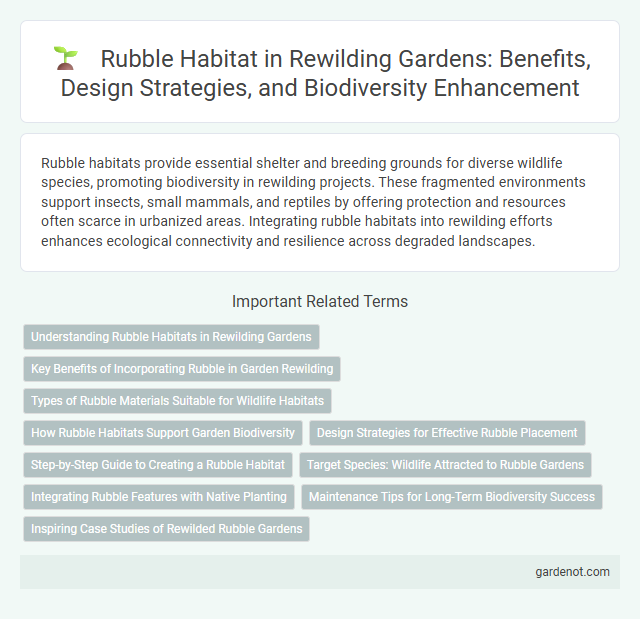Rubble habitats provide essential shelter and breeding grounds for diverse wildlife species, promoting biodiversity in rewilding projects. These fragmented environments support insects, small mammals, and reptiles by offering protection and resources often scarce in urbanized areas. Integrating rubble habitats into rewilding efforts enhances ecological connectivity and resilience across degraded landscapes.
Understanding Rubble Habitats in Rewilding Gardens
Rubble habitats in rewilding gardens consist of loose stones, bricks, and debris that create microenvironments supporting diverse flora and fauna, including insects, amphibians, and small mammals. These habitats enhance biodiversity by offering shelter, breeding sites, and feeding resources crucial for species that thrive in disturbed or urbanized settings. Incorporating rubble habitats effectively promotes ecological resilience and connectivity within rewilded landscapes.
Key Benefits of Incorporating Rubble in Garden Rewilding
Incorporating rubble habitats in garden rewilding enhances biodiversity by providing essential shelter and breeding grounds for insects, amphibians, and small mammals. The porous structure of rubble improves soil aeration and water retention, fostering healthier plant growth and supporting a resilient ecosystem. Rubble habitats also aid in natural pest control by attracting predatory species, reducing the need for chemical interventions.
Types of Rubble Materials Suitable for Wildlife Habitats
Rubble habitats consist of various types of debris, including concrete chunks, bricks, stones, and wood remnants, which provide diverse shelter and breeding opportunities for wildlife. Materials such as porous bricks and weathered concrete create microhabitats for invertebrates, reptiles, and small mammals by offering crevices and stable temperature conditions. Incorporating mixed rubble layers enhances biodiversity by supporting different species' nesting and foraging needs within urban and natural rewilding projects.
How Rubble Habitats Support Garden Biodiversity
Rubble habitats create essential microhabitats that support diverse garden biodiversity by providing shelter for insects, amphibians, and small mammals. The varied textures and crevices in rubble promote nesting opportunities and protect species from predators and harsh weather conditions. These structures also encourage the growth of mosses and lichens, contributing to a balanced ecosystem and enhanced pollination within the garden.
Design Strategies for Effective Rubble Placement
Effective rubble habitat design strategies emphasize creating heterogeneous structures with varied sizes and interstitial spaces to support diverse aquatic species. Strategic placement involves layering materials to enhance water flow and oxygenation while preventing sediment accumulation. Incorporating natural rock types and mimicking native habitat complexity improves ecological function and promotes biodiversity recovery.
Step-by-Step Guide to Creating a Rubble Habitat
Start by collecting diverse rubble materials such as broken bricks, stones, and concrete slabs to create a varied microhabitat. Arrange the rubble in layered piles with gaps and crevices to provide shelter for insects, amphibians, and small mammals. Monitor moisture levels and plant native vegetation nearby to promote a balanced ecosystem supporting biodiversity in the rubble habitat.
Target Species: Wildlife Attracted to Rubble Gardens
Rubble gardens create vital habitats that attract diverse wildlife, including amphibians such as newts and frogs, reptiles like lizards, and numerous invertebrates such as beetles and spiders. These structures offer shelter, breeding sites, and foraging opportunities for species adapted to rocky, loose substrates in fragmented urban and rural landscapes. Targeting species like hedgehogs and small mammals further enhances biodiversity and supports ecological networks within rewilding projects.
Integrating Rubble Features with Native Planting
Integrating rubble features with native planting enhances biodiversity by creating diverse microhabitats that support insects, reptiles, and small mammals. The porous structure of rubble retains moisture and provides shelter, promoting the growth of native wildflowers and grasses suited to local soil conditions. This combination fosters ecological resilience, encouraging natural succession and habitat connectivity within rewilding projects.
Maintenance Tips for Long-Term Biodiversity Success
Maintaining rubble habitats requires regular monitoring to prevent invasive species from overtaking native plants and wildlife, ensuring a balanced ecosystem. Periodic removal of excess debris and careful management of soil compaction help sustain microhabitats critical for invertebrates and small mammals. Incorporating native plant species around rubble areas promotes structural diversity, supporting long-term biodiversity and ecological resilience.
Inspiring Case Studies of Rewilded Rubble Gardens
Rubble gardens serve as transformative examples of rewilding, showcasing biodiversity returns in urban and post-industrial landscapes. The spontaneous growth of native flora in these areas fosters habitats for pollinators, amphibians, and small mammals, promoting ecosystem resilience. Notable case studies reveal increased species richness and ecosystem services, demonstrating that rewilded rubble gardens can effectively rehabilitate degraded spaces.
Rubble habitat Infographic

 gardenot.com
gardenot.com